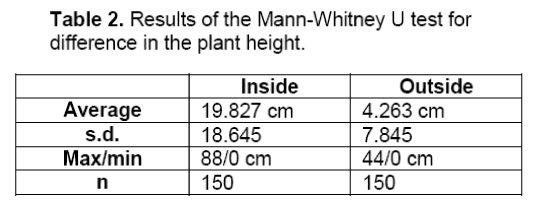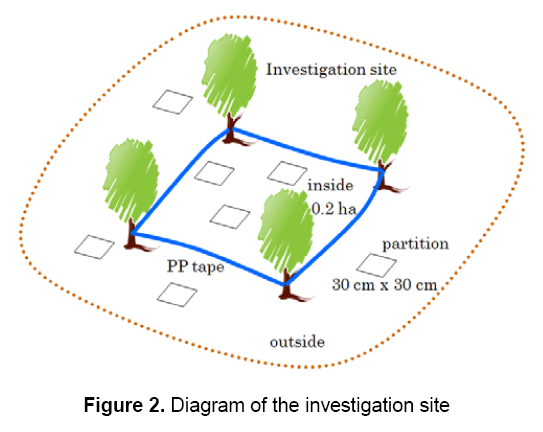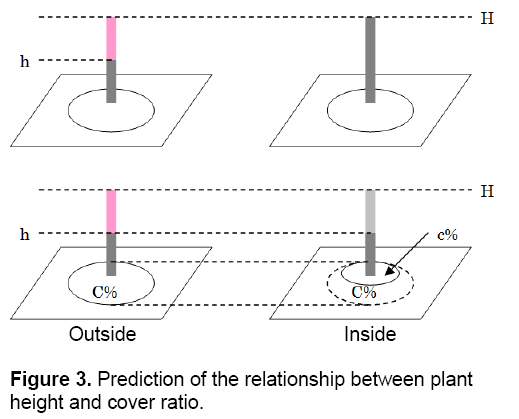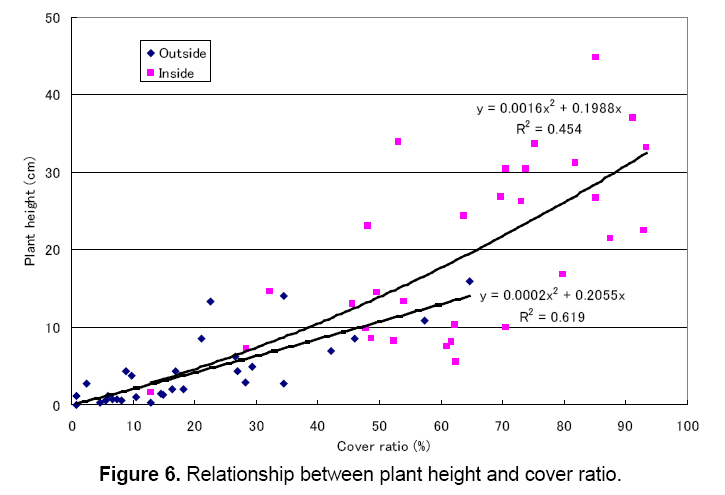A Simple and Cost-Effective Method to Prevent Sika Deer Grazing in Forests: Preliminary Results from Kyoto, Japan
Yukichika Kawata, Hideki Hatanaka, Hidekazu Mikita
1Department of Animal and Food Hygiene, Obihiro University of Agriculture and Veterinary Medicine, Hokkaido, Japan
2Kanbatsuzai Research Institute NPO, Kyoto, Japan
3Kyoto Veterinary Chutan Wide Area Promotion Bureau, Kyoto, Japan
- Corresponding Author:
- Tel: +81(0)155-49-5424
Fax: +81(0)155-49-5449
E-mail: ykawata@obihiro.ac.jp
Abstract
This study empirically examined the efficiency of a simple and cost-effective method used to prevent sika deer browsing/grazing in forests. Our method, which is referred to as the zig–zag tape approach (ZTA), is simple and requires no special techniques or prior training. The investigation site was a portion of a private forest in Kyoto, Japan. At the investigation site, we randomly selected 30 partitions inside and 30 partitions outside of the 0.2-ha exclosure. Plant cover ratios of the partitions in the two areas were compared, together with plant height and the number of signs of deer grazing on grasses. Plant cover ratio and height within the exclosure were both significantly higher than those observed outside the exclosure. The relationship between plant height and plant cover ratio is theoretically expected, and our results are consistent with this theoretical expectation. This implies that grazing pressure at the investigation site is stronger outside the exclosure than it is within. Indeed, signs of deer grazing on grasses were only detected outside the exclosure. This study thus empirically demonstrated that the ZTA is an effective method for preventing sika deer browsing/grazing.
Keywords
polypropylene (PP) tape, zig–zag tape approach, Japanese sika deer, browsing, grazing, forestry damage.
1. Introduction
In the last few decades, the population size of the Japanese sika deer (Cervus nippon) has increased throughout Japan due to several factors, including the absence of predators, decrease in hunting pressure, recent milder winters, and increase in the extent of abandoned agricultural land. The significant population growth of sika deer has had various effects, including forestry/agricultural damage, vegetation damage, and traffic accidents. In Kyoto Prefecture, forestry/agricultural damage attributable to sika deer population growth started to become serious in the mid-1980s. Since that time, the total amount of annual damage (in monetary base) has increased, and substantially so after the early 1990s. Damage to agricultural and forestry in 2010 was estimated at 44.114 million yen and 44.601 million yen, respectively (Kyoto Prefecture, 2012).
Deer guard fences are regarded as one of the most effective methods of preventing deer damage in forests. Approximately 1,720 km of deer guard fence was installed from 1996 to 2010 in Kyoto Prefecture (Kyoto Prefecture, 2012). In addition, the ban on female deer hunting was lifted in 1997 in an effort to decrease the population size of deer. Moreover, population management on the basis of scientific knowledge and methods has been recently initiated, involving the calculation of annual cull limits to lower the current population size by nearly half and to confirm whether or not the population size is decreasing as expected: if not, the cull limit of the next year will be adjusted to realize the target population size (Kyoto Prefecture, 2012). This series of procedures is usually referred to as feedback management.
However, certain issues have been raised regarding the current measures. First, installation of deer guard fences is expensive and can accordingly become a financial burden to the local government. Second, it is not easy to increase hunting pressure and fully achieve the annual cull target because the number of hunters has decreased. Third, erecting deer guard fences and hunting both require special techniques and can be difficult to implement. Fourth, there is no guarantee that specific sites, which are of particular importance, will be appropriately protected even after the installation of deer guard fences and the expansion of hunting.
The purpose of this study was to empirically examine the efficacy of a simple and cost-effective method of preventing sika deer browsing/grazing in forests. Our method, called the zig–zag tape approach (ZTA), is so simple that no special techniques and training are required for its use. The ZTA is usually applied to a small area of the forest that needs special attention to prevent sika browsing. In this paper, the term grazing pertains to deer browsing on both trees and grasses. In addition, the phrase grazing damage includes treading on grasses, which also decreases the amount of grass biomass.
The ZTA was developed by Mr. Hatanaka and the details of this technique have been described in Kawata et al. (2010). The ZTA involves the use of several small exclosure, created by using polypropylene (PP) tape to prevent grazing within the exclosure (Figures 1 and 2).
There are two main reasons for the effectiveness of the ZTA. First, deer will enter an area if it cannot find an easy way to escape from it. Therefore, deer will not attempt to enter an area that is isolated by PP tapes. Second, the physical movement of stepping inside the exclosure requires additional energy (calorie) consumption. If a deer finds sufficient grass outside the exclosure, there are no reasons to step into the exclosure, which will also require additional energy (Kawata et al., 2010).
Our investigation site was located in a private forest in Ayabe City, Kyoto. This site is managed by the Kanbatsuzai Research Institute, which is a non-profit organization (NPO) based in Kyoto. In 2005, Yamamomiji trees (Acer palmatum Thunb. var. matsumurae Makino) were planted in the investigation site as one of the main activities of this NPO. It was soon revealed that certain measures were needed to prevent deer damaging the planted trees. The NPO wanted to find a simple and cost-effective measure for the control of deer grazing, and the ZTA was thus selected in 2006.
Six years of implementation of the ZTA have resulted in the absence of deer activity inside the exclosure (hereafter referred to as inside). The next sections of this paper will describe a comparison of plant height and cover ratios within an exclosure and in the area surrounding (hereafter outside) the exclosure at the investigation site.
2. Methods
Site and date of investigation
The investigation site is a part of private forest in Ayabe City, Kyoto. Artificial forests dominate the area, with high densities for cedar (Cryptomeria japonica) and cypress (Chamaecyparis obtusa) because of the former forest policy of afforestation. The 0.2-ha exclosure was protected by PP tape in 2005.
The investigation was conducted on 13 May, 2012, with the selection of date being based on two major criteria. First, deer grazing pressure is most evident when new sprouts start to grow, which is generally from April to early May. Second, once the rainy season starts, grasses start growing, and thus the signs of deer grazing on grasses become less evident. Moreover, the increase in grass biomass prevents us from conducting investigations.
According to the prediction of the Japan Meteorological Agency, the rainy season in the Kinki area starts on 7 June, 2012 (Japan Meteorological Agency, 2012).
Investigation items
This study assumed that deer activity has been completely prevented since the installation of the PP tape at the site 6 years ago. Thus, we did not remove grass either inside or outside of the exclosure. We randomly selected 30 partitions (30 × 30 cm) within the areas inside and outside of the exclosure. We surveyed plant cover ratio and height, as well as the signs of deer grazing on grasses.
Plant cover ratio: Photographs of the 30 × 30 cm areas were taken from a height of approximately 70 cm. A wooden frame was used when taking pictures and the ratio of grass inside the wooden frame was then calculated. Several issues prevent us from using electronic photo-editing for ratio calculation. First, the colour of the grass was different because of the existence of a variety of grass species and differences in the amount of sunlight. Second, some partitions contained large amounts of fallen leaves.
Because the investigation was conducted at a time when there was a large biomass of grass, fallen leaves were excluded from the calculation of plant cover ratio even when the fallen leaves were green in colour.
Plant cover ratio was calculated on the basis of the following procedure. We evenly arranged 100 small squares within each partition in each photograph. The percentage of grass in each of the 100 small squares was estimated in the order of 5% in width, thus ranging from 0% to 100% using rough estimation. After measuring 100 small squares, the average plant cover ratio was calculated.
Plant height: We measured plant heights at the four corners and the centre of the square and the average of these 5 points was calculated.
Signs of deer grazing: Only signs of fresh deer grazing (i.e. vegetation grazed after January 2012) were examined.
To prevent inter-individual variation, data for each of the investigation items were collected by a single person.
Analytical methods
In this study, we hypothesized that both plant cover ratio and the height on the inside are higher than those on the outside (Hypotheses 1 and 2), and that the number of signs of deer grazing on the inside is less than those on the outside (Hypothesis 3). We examined these hypotheses using a non-parametric test.
The hypothesis that the number of signs of deer grazing on the inside is less than those on the outside was based on the relationship between the plant cover ratio and height. Given the same level of the plant cover ratios for the inside and outside, the plant heights on the inside must be higher than those on the outside (Hypothesis 3–A). Likewise, given the same plant heights for the inside and the outside, the plant cover ratio on the inside must be lower than that on the outside (Hypothesis 3–B).
Hypotheses 3–A and 3–B can be explained on the basis of Figure 3. First, let us examine hypotheses 3–A. As the upper diagram of Figure 3 shows, if the plant cover ratios are the same on the inside and outside, the plant height outside (h) is less than that inside (H) because the plant area on the outside is under a stronger grazing influence. Grazed parts of the plants are shown with a red bar in the upper diagram of Figure 3.
Let the plant cover ratio and plant height be represented as horizontal and vertical axes, respectively. If curves showing the relationship between plant cover ratio and height on the inside and outside are drawn, the curve representing the inside relationship should be located on the upper side of curve representing the outside relationship.
3. Results and Discussion
Comparison of cover ratios
Average cover ratio and standard deviation (s.d.), the maximum and minimum cover ratio, and sample size are shown in Table 1. The average plant cover ratios for the inside and outside were 63.803% and 19.910%, respectively. Figure 4 shows a histogram of the plant cover ratios. The peak of histogram for outside is 0–20%, with 18 partitions. As the plant cover ratio increases, the number of partitions decreases. No partition with plant cover ratio of 81–100% was observed. On the other hand, the peak of the histogram for the inside was 61–80%, with 12 partitions.

We examined the differences in plant cover ratio between the inside and outside areas using the Mann–Whitney U test. We used the SPSS Statistics 17.0 provided by WinWrap Basic for this analysis. The null hypothesis was that the distributions of the cover ratio on the inside and the outside are the same. Test statistic U = 52.0 (with Z = –5.884 and asymptotic significance probability = 0.000) and the null hypothesis was rejected at the 1% significance level, indicating that the cover ratio on the inside and outside areas are statistically different.
Comparison of plant height
We measured the plant height at 5 points within each partition. The number of partitions on the inside and the outside was 30 and 30, respectively. Therefore, the number of samples on the inside and outside was 150 and 150, respectively.
Average cover rate and standard deviation (s.d.), maximum and minimum plant heights, and sample size are presented in Table 2. The average plant heights on the inside and outside areas were 19.827 and 4.263 cm, respectively. Figure 5 shows a histogram of the plant height. The histogram peaks for the inside are 0 cm and 21–40 cm, with 15 and 32 partitions, respectively. The histogram peak for the outside is 0 cm, with 82 partitions.

We examined the differences in plant height between the inside and outside areas using the Mann–Whitney U test. The null hypothesis was that the distributions of the plant height on the inside and the outside are the same. Test statistic U = 4135.5 (with Z = -9.635 and asymptotic significance probability = 0.000) and the null hypothesis was rejected at the 1% significance level, indicating that the plant height on the inside and outside areas are statistically different.
Relationship between cover ratio and plant height
Figure 6 shows the relationship between plant cover ratio and plant height (represented as horizontal and vertical axes, respectively). Data for the outside area are represented by blue diamonds, which are mainly located in lower left area of the graph, and data for the inside area are represented by red squares, which are mainly located at top right of the graph. In both cases, a positive correlation was observed for plant cover ratio and height. Quadric curves were generated by drawing a line through the point of origin. As expected, the curve representing the inside relationship was located in the upper region of curve, representing the outside relationship, indicating that plants on the outside are under stronger grazing pressure by sika deer compared to those on the inside.
There were signs of deer grazing on grasses in 0 and 9 partitions on the inside and the outside, respectively. These results are consistent with the results of the curve positions. Therefore, these results show that the grazing pressure is stronger on the outside and that there might be no grazing on inside.
4 Conclusions
In this paper, we describe a simple and cost-effective method for effectively preventing sika deer grazing in forests in Kyoto, Japan. We randomly selected 30 partitions within the areas inside and outside of the exclosure and compared these in terms of plant cover ratios and height and the number of signs of deer grazing on grasses. The plant cover ratio and height of the inside area was statistically significantly higher than that of the outside area. The relationship between plant height and cover ratio is theoretically expected. Our results are consistent with the theoretical expectation, which implies that grazing pressure is stronger on the outside than on the inside. Indeed, new fresh signs of deer grazing on grasses were only detected in the outside area. Therefore, the results of this study empirically demonstrate that the ZTA is an efficient method for preventing sika deer browsing/grazing.
Acknowledgments
The authors extend their gratitude to the members of the Kanbatsuzai Research Institute NPO for keeping the research field under appropriate conditions for this research.
References
- Japan Meteorological Agency. (2012) Expected Dates of the Beginning and the End of the Rainy Season in 2012 (Advance announcement). https://www.data.jma.go.jp/fcd/yoho/baiu/sokuhou_baiu.html
- Kawata Y, Hatanaka H, and Mikita H. (2010) Experimental Project on Simple Method for Preventing the Deer Invasion: Zig-zag Tape Project. Field Note (105): 3-8. (in Japanese)
- Kyoto Prefecture. (2012) Conservation and Management Plan for the Japanese Sika Deer, 3rd edition. (in Japanese)

Open Access Journals
- Aquaculture & Veterinary Science
- Chemistry & Chemical Sciences
- Clinical Sciences
- Engineering
- General Science
- Genetics & Molecular Biology
- Health Care & Nursing
- Immunology & Microbiology
- Materials Science
- Mathematics & Physics
- Medical Sciences
- Neurology & Psychiatry
- Oncology & Cancer Science
- Pharmaceutical Sciences






